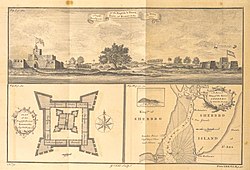
| Fort Komenda | |
|---|---|
| Part of British Gold Coast | |
 British Fort Komenda (left) and Dutch Fort Vredenburgh (right). Note the peculiar architecture of Fort Komenda in the plan of the fort (lower left). | |
| Coordinates | 5°03′00″N1°29′22″W / 5.050000°N 1.489444°W |
| Site history | |
| Built | 1682 |
| Garrison information | |
| Occupants | Britain (1695-1868) Netherlands (1868-1872) |
| Part of | Forts and Castles, Volta, Greater Accra, Central and Western Regions |
| Criteria | Cultural: (vi) |
| Reference | 34 |
| Inscription | 1979 (3rd Session) |
Fort Komenda was a British fort on the Gold Coast, currently preserved as a ruin. [1] Because of its testimony to the Atlantic slave trade and European economic and colonial influence in West Africa, the fort was inscribed on the UNESCO World Heritage List in 1979, along with several other castles and forts in Ghana. [2]





